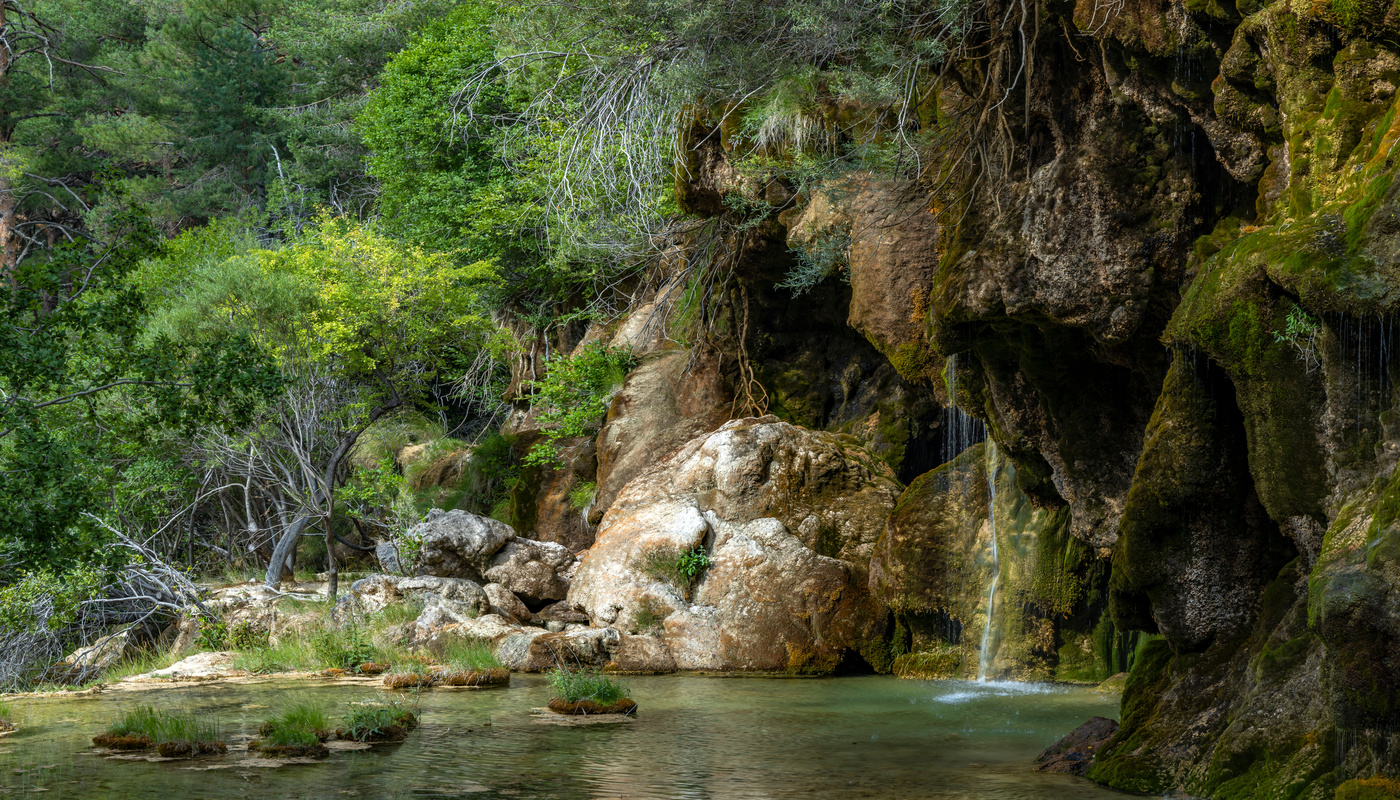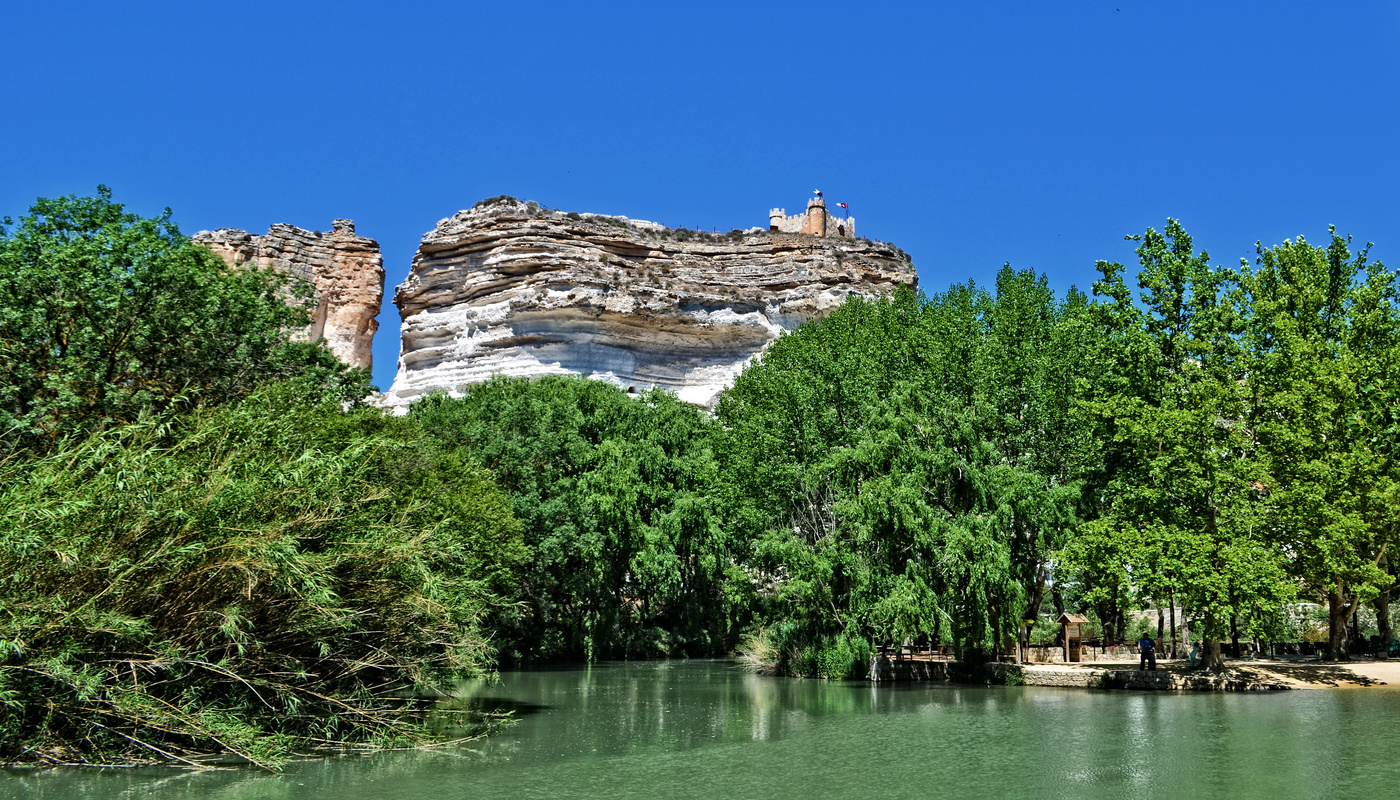Birthplace of the Cuervo and Júcar rivers: a guide to the rivers of Castilla-La Mancha
We present you with a magnificent guide to the sources of the Cuervo and Júcar rivers along with other hidden spots in this region of Castilla-La Mancha!
TRAVELLING WITH TASTE
Share

Cuervo River Source, Routes, and Waterfalls
In the heart of the Serranía de Cuenca lies one of the most beautiful natural gems of the province. It is a unique environment that was recognised as a natural monument in 1999. It is a dreamlike setting that is home to one of the most impressive walks in Spain. Its waterfalls and easy trail make it suitable for all ages.
It can be visited at any time of the year, although the best seasons are winter and spring when water is plentiful, and you can enjoy it in its full splendour.
The route to the source of the Cuervo River begins in the car park. It is a circular route of just over three kilometres, simple and perfect to do with children or friends. Shortly after starting, you will reach a rest area with picnic tables and a restaurant. Once past it, you will enter the area equipped with walkways, bridges, and stairs that gradually introduce the traveller to the spring's shores.
The tree-lined landscape is spectacular and you can also enjoy the area where the waterfalls are located. A short distance away is one of the largest waterfalls in the area (not the one which lies at the source of the river). After the waterfall and following the river's course, you will reach the source of the Cuervo River. To reach it, you will have to go past a small viewpoint where you can observe the greatness of these waterfalls. Later, you will pass through an extensive meadow and, following the path, you will reach the source.
Other routes include the Turbera trail, a route that starts about 150 meters before the river's source, with a length of one and a half kilometres, passing through a limestone peat bog. The Pinar route, about 11 kilometres long, is accessed via the Turbera trail, allowing a journey through the Scots pine forest and marvelling at incredible panoramic views. However, the Serranía de Cuenca natural park contains a total of 11 routes suitable for hiking and environmental education. They are all waymarked and involve different levels of difficulty.
Júcar River Source
The Júcar River originates in the Serranía de Cuenca, in a place known as Los Ojuelos de Valdeminguete, at the bottom of the valley that separates the Muela de SanFelipe from the Muela de la Mogorrita, the two highest peaks in the province.Four kilometres from the town of Tragacete, at the San Blas Hostel, begins the trail that leads to the Molino de la Virgen waterfall, a beautiful waterfall about twenty metres high, and the perfect prelude to the wonders of theupper basin of the Júcar River.
The Júcar Canyon
This is a dizzying landscape. Between the municipalities of Jalance and Cofrentes, we discover the Júcar River, nestled between enormous natural walls over 300 metres high. A magical and impressive space with ravines, Mediterranean forests, tunnels dug into the rock... This is a circular route of 33 kilometres that starts from Jalance and can be covered in about 10 hours, so it is not suitable for everybody - some training is required. A shorter section of about 16 kilometres can also be walked.
On this hike, we will come across the cave of Don Juan, with remains from the Mesolithic period. Used as a dwelling in antiquity and later as a refuge for shepherds and hunters, the cave can be visited. It is about 500 metres deep and the guided tour takes about 40 minutes. The start of the route can be accessed by private vehicle with a car park nearby.
You can admire the landscape from several viewpoints: Campichuelo, Cañones del Júcar and the Castle fountain, equipped with tables, benches and a fountain. Other recreational areas nearby are Moragete and the cave of Don Juan, Fuente Bella and Fuente del Tobarro, this latter in the municipality of Jarafuel, in the region of Valle de Ayora.
To begin the return journey, we must pass the Centenillos path, the Star bridge, the New bridge, and a ravine known as the Barranco del Agua. There are numerous points of tourist interest, including the Moragete Nature Classroom and the river's springs. For lovers of river walks, Cofrentes offers the first river route in the Valencian Community. It is an hour-long route along the Júcar River, starting in this town and ending at Cortes de Pallás.

Discover the Hoz del Júcar
If you are looking for your next rural escapade, in the Hoz del Júcar you will find an ideal place to spend a few days surrounded by nature and beautiful landscapes.
In the northeastern tip of the province of Albacete, we find one of the most surprising places in all of Castilla-La Mancha: the Hoz del Júcar, a product of the erosive action of the waters of the Júcar River before it joins with the Cardiel at the Embarcadero reservoir.
La Hoz del Júcar, in La Manchuela, is a surprising area that offers a very picturesque landscape with river canyons and villages that almost seem to be floating. An area of great contrasts with vegetation and large orchards in some sections. In others, the river is more sinuous and generates abrupt meanders that pass between canyons.
To the north of the Hoz del Júcar are the last foothills of the Iberian System; to the south, the first heights of the Betic Mountain Range rise up, and, finally, to the west extend the great plains of La Mancha. A space of great natural value where we also find several towns that have played an important role in the history of Spain and feature interesting popular architecture and monuments, such as Alcalá del Júcar, Tolosa, Casas del Cerro, Jorquera...
What to eat between hikes
- Zarajos: very popular in Cuenca cuisine, Zarajos - a lamb's small intestine wrapped around a stick - are also consumed in Madrid and have similar "cousins" without a stick inNavarra and La Rioja, where they are known as embuchado, and in Aragon, as madejas. Zarajos are usually fried or grilled.
- Migas: the most famous typical dish of Castilla-La Mancha. It contains small pieces of stale bread sautéed in oil with garlic, bacon, chorizo, and paprika. They are often accompanied by white grapes and a fried egg on top.
- Gazpacho manchego: this is a soupy (hot) stewcooked with meat (rabbit, chicken or partridge) and whose main ingredients are pieces of Manchego flatbread, an unleavened bread that is prepared without yeast.
- Morteruelo: Guadalajara, Albacete and,above all, Cuenca are responsible for the existence of this dish of medieval origin. Its main ingredients are pork liver and game meat. It is cooked with crumbled or shredded bread and spices (cinnamon and cumin).
- Alajú: this is one of the most typical sweet treats of Cuenca. Its main ingredient is almonds, along with breadcrumbs and honey, although pine nuts and walnuts can be added.It is a dough with honey, spices, breadcrumbs, toasted bread and nuts.






